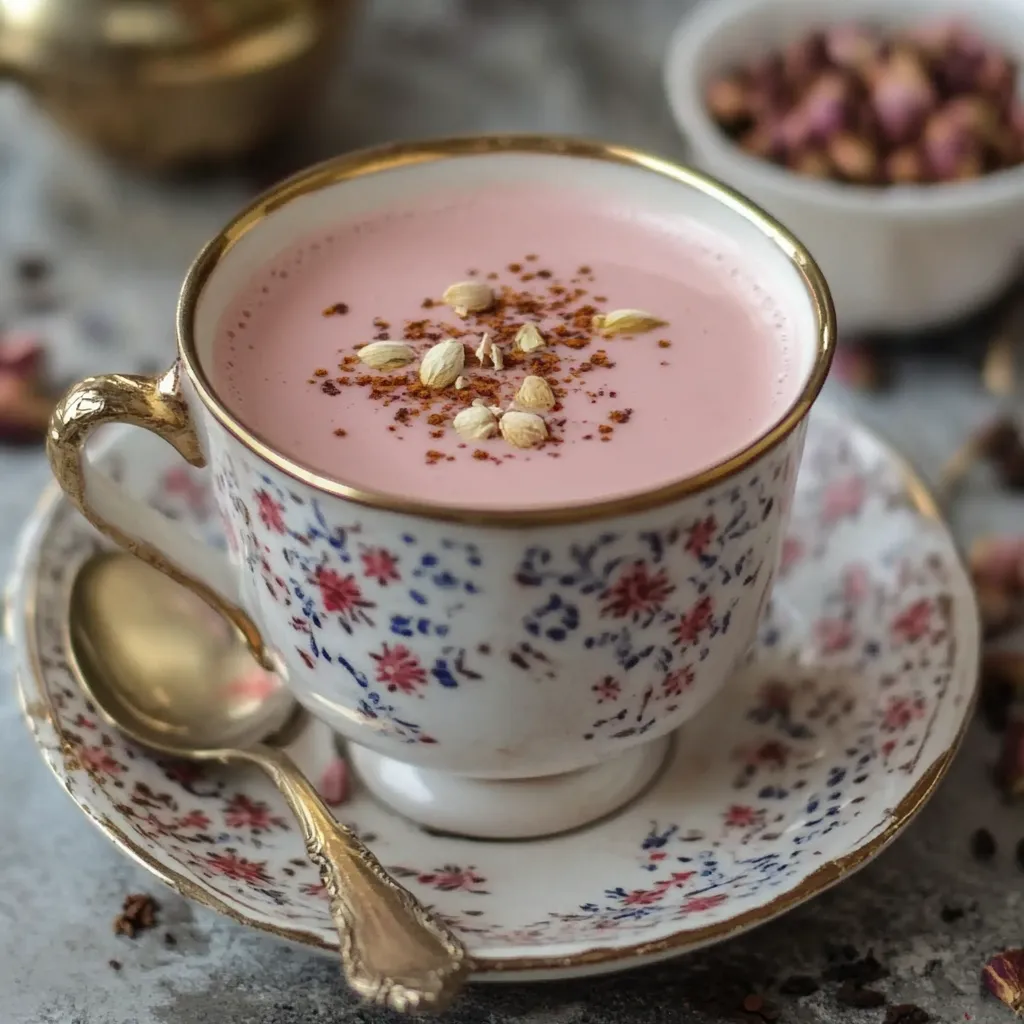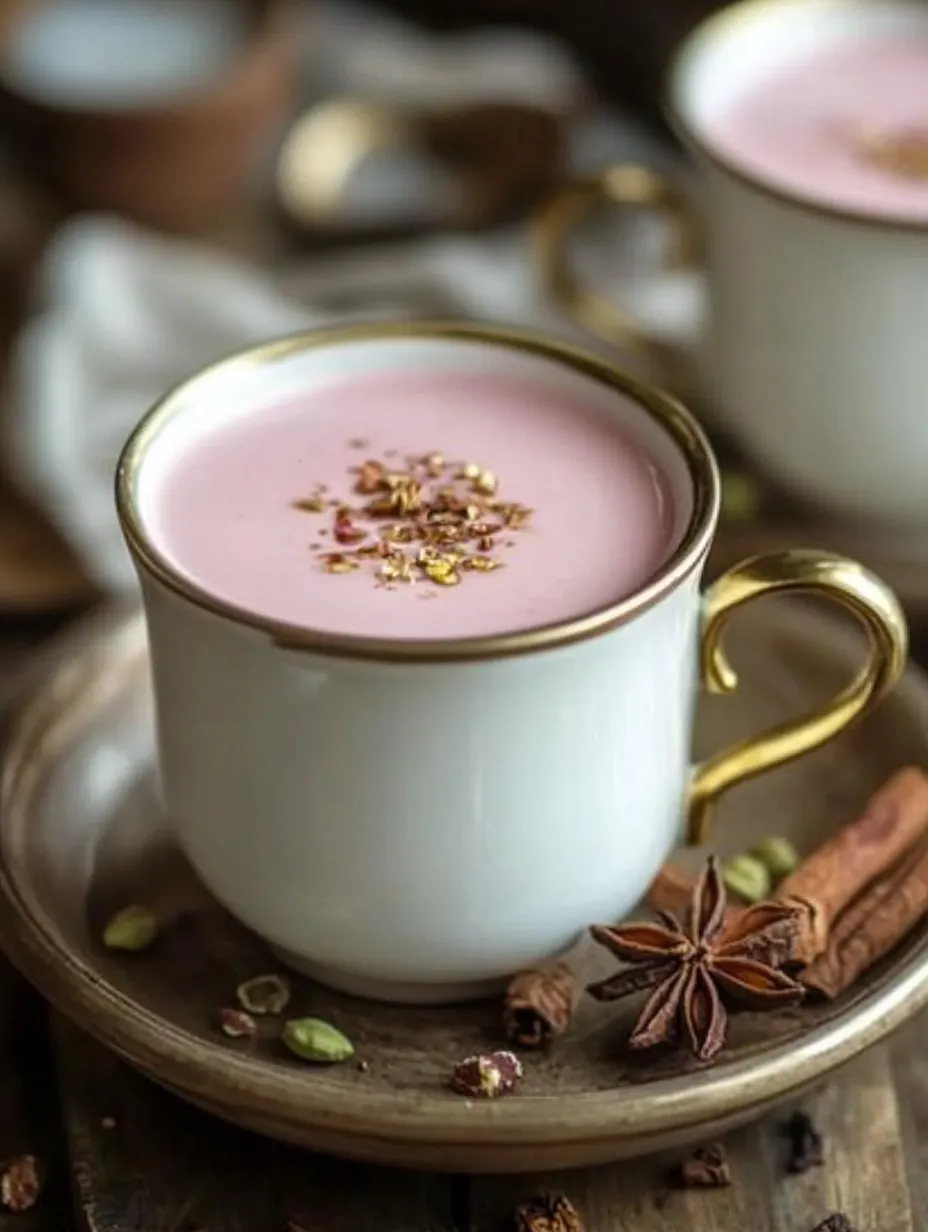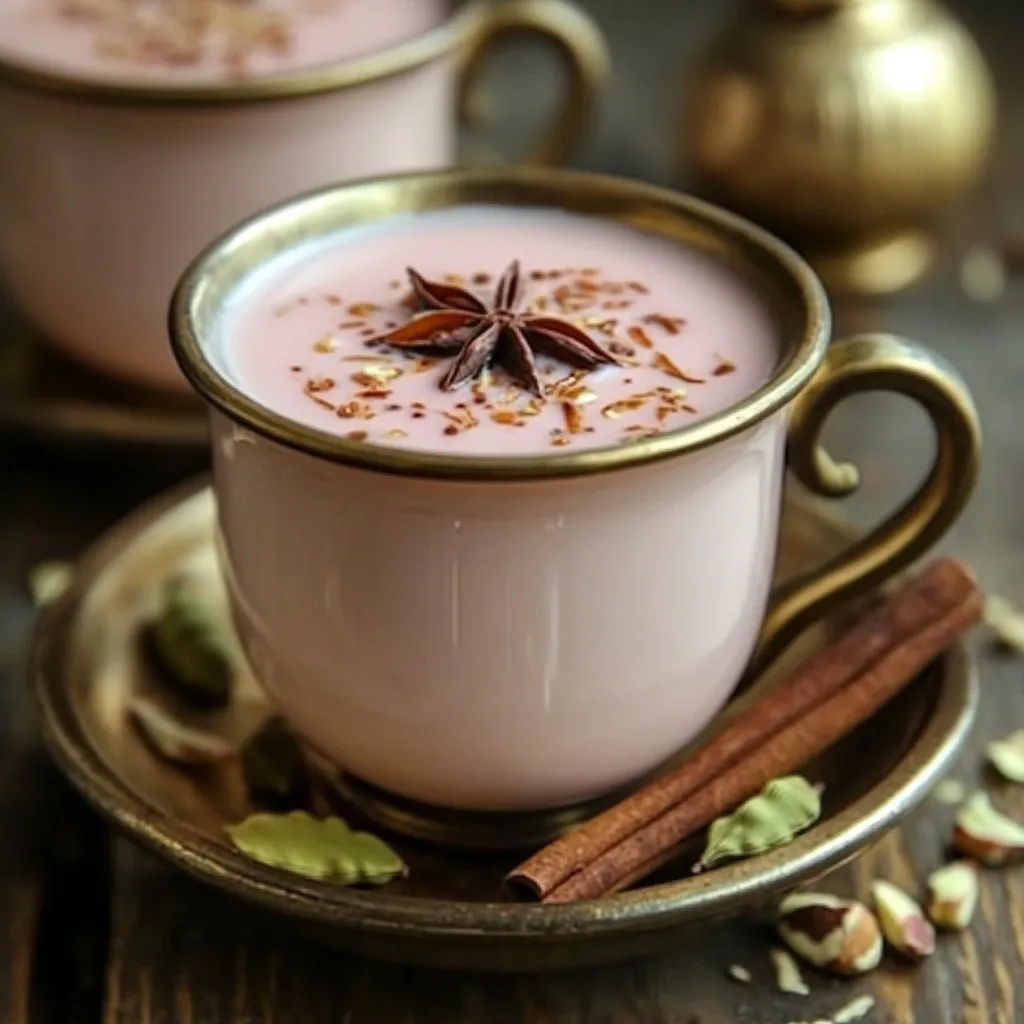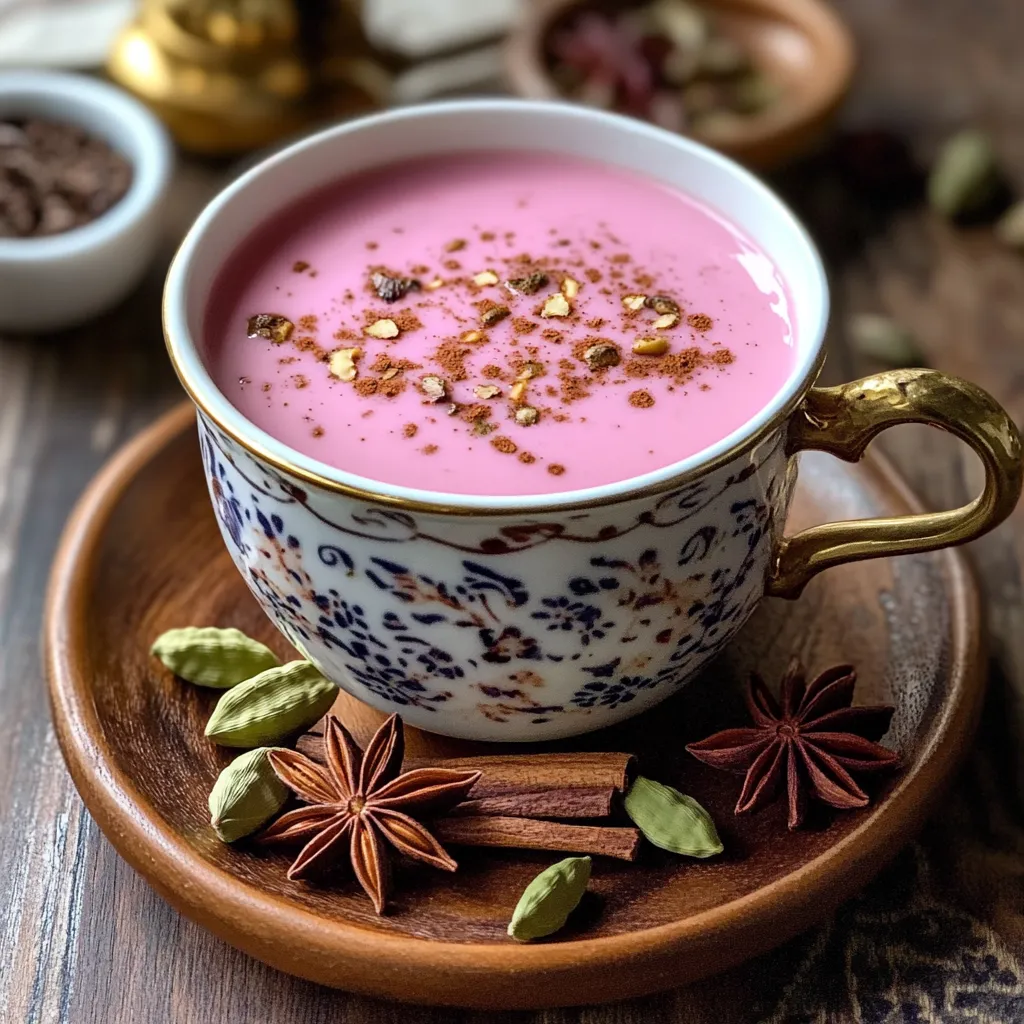 Pin
Pin
The captivating rosy color and fragrant seasonings of Kashmiri Pink Chai craft a unique sensory journey that transcends typical tea. This age-old method utilizes green tea, warm aromatics, and a hint of sodium chloride to produce an exceptionally soothing drink that is both visually striking and profoundly gratifying.
Preparing this chai in my personal cooking space invariably evokes memories of my inaugural experience with it in a quaint Kashmiri tea establishment. The proprietor disclosed that the essence resides in patient steeping and meticulous attention to temperature regulation.
Essential Ingredients
- Kashmiri Green Tea: The time-honored selection, though standard green tea functions adequately.
- Baking Soda: The key component for the characteristic rosy pigmentation.
- Whole Milk: Yields the quintessential velvety smoothness.
- Star Anise: Imparts subtle anise-like hints.
- Cardamom: Unbroken pods offer a more intense essence compared to pre-ground alternatives.
- Salt: Avoid omitting; it elevates all other tastes present.
Throughout my years of chai preparation, I've come to realize that prime constituents and suitable procedure transform a palatable cup into an extraordinary indulgence.
Detailed Instructions
- 1. Initial Brewing:
- Begin with pristine, chilled water within a heavy-based saucepan. Bring to a vigorous boil before the introduction of tea granules. The aqueous temperature influences the manner in which the tea discharges its inherent essences.
- 2. Color Development:
- Incorporate bicarbonate of soda incrementally, blending with care. Observe the captivating chromatic transition - from viridescent to russet-brown. This chemical action is paramount in attaining the ultimate roseate coloration.
- 3. Spice Infusion:
- Introduce star anise, lightly crushed cardamom pods, and cinnamon stick. Permit gentle simmering at a low heat setting, enabling the spices to disseminate their aromatic oils. Monitor for a reduction in liquid volume by half, thus intensifying the tastes.
- 4. Milk Integration:
- Introduce milk via a consistent stream while concurrently mixing. The blend will progressively evolve into its trademark pink pigmentation. Sustain a moderate temperature to preclude any scorching.
- 5. Final Simmering:
- Maintain simmering for a duration of 10-15 minutes, agitating occasionally. The chai should acquire a luscious, creamy density accompanied by a vivid roseate shade.

Each dawn in Kashmir commences with the steady cadence of timber mallets churning this roseate concoction within capacious samovars fashioned from copper. My maternal aunt instructed me that perseverance during the gentle simmering stage cultivates the most profound tastes.

Perfect Tea Selection
Opt for complete leaf green tea for superior outcomes. Refrain from utilizing tea contained within sachets as they may render the chai with a bitter edge.
Temperature Control
Maintain a temperate heat setting subsequent to milk addition. Excessive heat may precipitate curdling and negatively impact the conclusive coloration.
Spice Balance
Lightly heat whole spices prior to incorporation to heighten their fragrance. Modify quantities contingent upon individual gustatory inclinations.
Brewing Traditions
The skill of preparing Kashmiri Pink Chai stretches back centuries, relayed across generations in the Kashmir Valley region. Each familial unit contributes their distinctive refinement while upholding the fundamental facets that render this potable unique. From the energetic thoroughfares of Srinagar to tranquil mountainous abodes, the custom of concocting noon chai unites individuals. The roseate tint, realized through attentive oxidation, signifies more than mere visual allure - it serves as an affirmation of the preparer's proficiency and endurance. Contemporary iterations welcome novel components whilst venerating conventional methods.
Cultural Significance
Within Kashmir, pink chai embodies friendliness and societal bonding. Customarily presented at nuptials, domestic assemblies, and religious observances, it transcends mere refreshment - it functions as a conversational initiator and communal keystone. The warming attributes of the seasonings render it particularly sought after amidst Kashmir's frigid winters. Numerous families still employ age-old copper samovars, holding the belief that these enhance the tea's essence. The incorporation of fragmented nuts, notably pistachios and almonds, mirrors the region's profusion of desiccated fruits.
Health Benefits
Beyond its opulent flavor profile, Kashmiri Pink Chai extends numerous wellness advantages. The verdant tea foundation furnishes antioxidants, whilst cardamom facilitates digestion. Cinnamon assists in glucose level regulation, and star anise presents anti-inflammatory characteristics. The sodium chloride proportion contributes to maintaining electrolyte equilibrium, notably advantageous during periods of cold weather. The amalgamation of lacteal fluid and seasonings engenders a warming sensation that Kashmiris deem instrumental in sustaining bodily warmth throughout harsh winters. The distinctive preparatory approach also augments the bioavailability of particular nutritive elements.
Modern Adaptations
Up-to-date versions of roseate chai accommodate dietary selections whilst preserving its core nature. Plant-based substitutes employing almond or oat milk yield equally creamy outcomes. Select establishments propose sugar-reduced variants sweetened via dates or stevia extract. The traditional formulation has inspired inventive variations such as roseate chai frozen desserts, lattes, and even sweet courses. Social media platforms have stimulated worldwide fascination with this singular beverage, prompting fusion-based recipes that meld Kashmiri customs with global tastes.
Serving Suggestions
Roseate chai harmonizes exquisitely with customary Kashmiri breads such as girda or lavasa. For an updated perspective, present it adjacent to butter-rich biscuits or shortbread. The tea can be relished across the diurnal cycle, yet proves particularly comforting as a breakfast beverage or midday revitalization. During summer seasons, a chilled form delivers invigorating respite. Certain aficionados appreciate it as a dessert potable, complementing its inherent sweetness via honey or condensed milk. The mode of presentation holds significance - conventional copper cups amplify both visual charm and flavor perception.

The artistry of crafting impeccable Kashmiri Pink Chai resides in comprehending the manner in which each constituent contributes to its singular essence. This recipe provides a connection to centuries-old practices while concurrently fashioning new recollections surrounding each vaporous cup.
Recipe FAQs
- → Why does the tea turn pink?
- The chemical reaction between the tea, baking soda, and milk causes the color change from red to pink. It's a natural process unique to this preparation method.
- → Can I use regular green tea?
- Yes, though traditional Kashmiri tea gives the best results, regular green tea will work. The color might be slightly different but still beautiful.
- → Why does it take so long to make?
- The long simmering time is essential to develop the proper color, reduce the liquid, and intensify the flavors for authentic taste.
- → Is baking soda necessary?
- Yes, baking soda is crucial for the chemical reaction that creates the signature color change and traditional taste.
- → Can I make this dairy-free?
- While traditional recipe uses whole milk, you can experiment with full-fat plant milk, though color and taste will vary.
